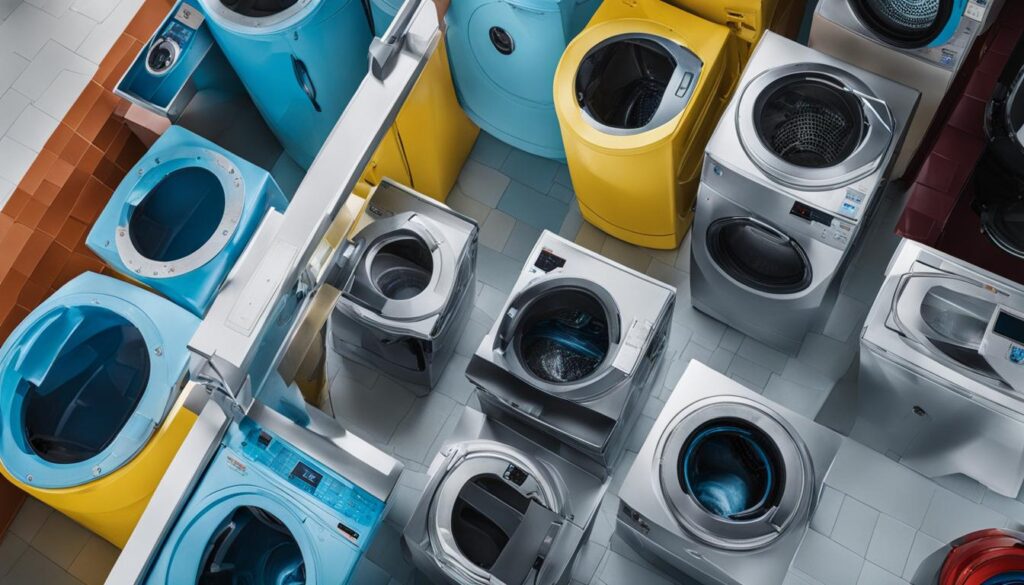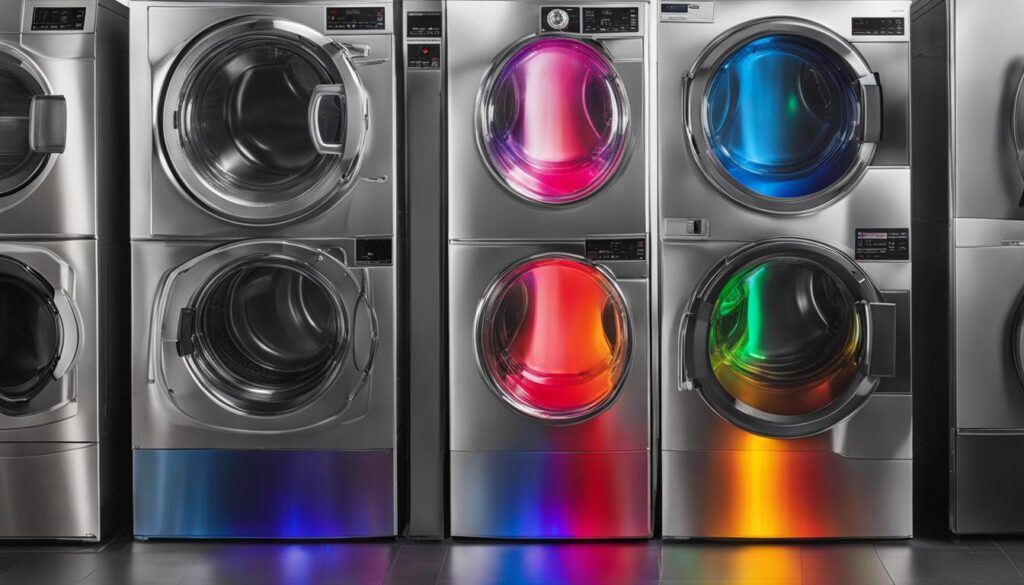Welcome to our article on laundromat water temperature options. In this guide, we will delve into the different water temperature settings available in laundromats and provide insights on how to choose the ideal temperature for your laundry needs. Finding the perfect balance between effective cleaning and fabric care is essential for achieving optimal results, and we’re here to help you navigate through the options.
Key Takeaways:
- Understanding the effects of hot water and its impact on fabric care and soil removal.
- Exploring the benefits of using warm water in laundromat washers for balanced cleaning.
- Discovering how cold water can be a suitable option for specific items and stain removal.
- Choosing the correct washing temperature based on garment care labels and stain types.
- The importance of consulting commercial laundry experts for guidance on temperature settings.
Understanding the Effects of Hot Water
When it comes to laundromat water temperature options, hot water is often considered the go-to choice for removing heavy soil and germs from white clothing and linens. With its high temperature, hot water can effectively break down dirt particles to achieve a thorough clean. However, it’s important to be aware of the potential effects that hot water can have on different fabrics.
Shrinkage, Wrinkling, and Color Fading
One of the drawbacks of using hot water in laundromats is the risk of shrinkage, wrinkling, and fading of colors. Certain fabrics, such as cotton and wool, are more prone to shrinking when exposed to hot water. This can result in clothes that no longer fit properly or have a distorted shape.
Additionally, hot water can cause wrinkles to set in, making it harder to achieve a smooth and wrinkle-free appearance. This is especially noticeable in fabrics like linen and silk. Furthermore, colors may fade more quickly when washed in hot water, compromising the vibrancy and longevity of your garments.
Before opting for the hot water setting in laundromat machines, it’s crucial to consider the fabric type and care instructions for your garments. Delicate fabrics, such as silk and lace, may lose their aesthetic appeal and structural integrity when subjected to hot water. These fabrics often require specialized care, including gentle washing with cold or lukewarm water.
It’s best to consult the garment’s care label for specific instructions regarding water temperature. The care label provides essential information on how to care for the fabric and maintain its quality over time. By following these guidelines, you can ensure that your clothes remain in excellent condition, even if you utilize the hot water option in laundromats for other items.
| Pros | Cons |
|---|---|
| Effective for removing heavy soil and germs | Risk of shrinkage, wrinkling, and fading of colors |
| Thoroughly cleans white clothing and linens | May damage delicate fabrics |
The Benefits of Using Warm Water
When it comes to laundromat washers, finding the right water temperature setting is essential for achieving clean and fresh laundry. While hot water is great for heavy soil and germs, and cold water is suitable for delicate fabrics, there is another option that strikes the perfect balance – warm water.
Warm water, which is a mixture of hot and cold water, offers a range of benefits for your laundry needs. It provides adequate soil removal without the risk of damaging your clothes. By using warm water, you can enjoy the following advantages:
- Gentle on fabrics: Unlike hot water, which may cause shrinking or fading of colors, warm water is gentle on most fabrics. It helps maintain the integrity of your clothes while effectively washing away dirt and stains.
- Color protection: Warm water helps preserve the vibrancy of colors in your laundry. It prevents excessive fading and ensures that your brightly colored clothes stay looking their best.
- Soil removal: The combination of hot and cold water in warm water settings offers a balanced approach to soil removal. It effectively removes dirt and stains from your clothes without subjecting them to harsh conditions.
When using warm water in laundromat machines, it’s important to adjust the water temperature accordingly. The ratio of hot and cold water may vary in different machines, so make sure to find the ideal setting that provides the right balance for your laundry load.
Expert Tip:
“For optimal results, consider sorting your laundry based on fabric type and care instructions. This will help you identify which items are suitable for warm water washing, ensuring the best care for your clothes.”
Now that we understand the benefits of using warm water in laundromat washers, let’s explore the effects of cold water washing and stain removal in the next section.
Choosing Cold Water for Specific Items
Cold water is a great option to consider when laundering delicate items or clothing with bright colors that may fade or run at higher temperatures. By using cold water, you can help preserve the vibrancy and integrity of your garments while still achieving effective cleaning results.
However, it’s important to note that if these delicate or brightly colored items are dirty or heavily soiled, cold water alone may not be sufficient to remove stains or grime. In such cases, implementing a diligent pretreatment routine can help ensure thorough cleaning.
Pre-soaking: Before laundering, consider pre-soaking heavily soiled items in a solution of water and laundry detergent or a stain remover specifically formulated for the type of stain you’re dealing with. This will help break down and loosen the dirt or stain, allowing for better cleaning results when washed in cold water.
Longer wash times: If you’re using cold water to clean heavily soiled items, extending the wash cycle duration can aid in achieving a more thorough clean. The additional time allows the detergent and water to work together to lift and remove dirt and stains from your garments.
It’s essential to keep in mind that cold water may not be as effective as hot or warm water in removing certain types of stains. Pre-treating stains is a crucial step to ensure the best possible results when using cold water.
Advantages of Cold Water for Delicate Items
When it comes to delicate items, such as lingerie, lace, silk, or certain types of wool, cold water is the ideal water temperature. Cold water minimizes the risk of shrinking or damaging these delicate fabrics during the wash cycle, prolonging their lifespan.
Cold water is particularly effective for preventing color bleeding in garments, preserving the vividness of bright or dark colors, and maintaining the integrity of prints and patterns. By using cold water, you can help ensure that your clothing looks fresh and vibrant for longer.
| Advantages of Cold Water for Delicate Items: |
|---|
| Gentle on delicate fabrics |
| Prevents shrinkage and damage |
| Preserves vivid colors and prints |
| Reduces color bleeding |
Determining the Correct Washing Temperature
When it comes to choosing the correct washing temperature for your laundromat machines, there are a few key factors to consider. One of the first things you should do is check the clothing tag for instructions on the maximum wash temperature. This will ensure that you avoid any mishaps and prevent damage to your garments.
Additionally, pre-treating stains and soaking clothes in cold water before washing can help achieve a thorough clean even if you’re limited to a cold water cycle. This is especially useful for delicate fabrics that may be more prone to damage at higher temperatures.
Monitoring the water temperature of your washing machine is crucial for proper cleaning. It not only ensures that you’re using the right temperature setting but also indicates if there may be a need for maintenance or repair. Keeping an eye on the water temperature will help you maintain the efficiency and effectiveness of your laundromat machines.
Remember, choosing the correct washing temperature is essential for both garment care and achieving the best cleaning results. By following the clothing tag instructions, pre-treating stains, and monitoring water temperature, you can confidently select the optimal temperature setting for your laundromat washing machines.
Finding the Right Washing Machine
When it comes to choosing the perfect washing machine for your laundromat, there are several important factors to consider. Not only do you want a machine that delivers excellent cleaning performance, but you also need one that allows you to adjust the water temperature to achieve the ideal wash for different types of laundry. By taking into account energy efficiency, water consumption, and temperature settings, you can find a washing machine that meets your specific needs.
Start your search by looking at reputable brands known for their quality and reliability. Brands like Maytag, LG, and Speed Queen are popular choices among laundromat owners, offering a range of models with various temperature options. Consider their reputation for durability and customer satisfaction to ensure a long-lasting investment for your business.
In addition to brand reputation, energy efficiency is another crucial factor to consider. Look for washing machines that have earned the ENERGY STAR certification, as these models meet strict standards for energy-saving performance. Investing in energy-efficient machines not only helps reduce your carbon footprint but also lowers your utility costs in the long run.
Another key consideration is water consumption. Choose a washing machine that minimizes water usage without compromising on cleaning effectiveness. Look for models that offer load-sensing technology, which adjusts the water level based on the size of the laundry load. This feature helps conserve water while still ensuring thorough cleaning.
Lastly, prioritize machines that provide a wide range of temperature settings. Having the flexibility to adjust the water temperature allows you to cater to different fabrics and stains, achieving the best wash results. Look for machines that offer hot, warm, and cold water options to accommodate a variety of laundry needs.
By considering these factors and researching different washing machine options, you can find the perfect match for your laundromat. Remember, investing in a reliable, energy-efficient machine with temperature control capabilities is essential for meeting your customers’ laundry needs while maintaining the quality and longevity of their garments.
The Impact of Water Temperature on Laundry Efficiency
The choice of water temperature significantly affects the efficiency and effectiveness of laundry operations. Depending on the temperature setting, different benefits and considerations come into play. Let’s explore how the laundromat water temperature options can impact laundry efficiency.
The Power of Hot Water
Hot washing at specific temperatures provides thermal disinfection and superior wash quality. The high temperature helps to eliminate germs and remove heavy soil from garments effectively. However, it’s important to note that using hot water may result in longer cycle times and potential damage to heat-sensitive fabrics.
Benefits of Warm Water
Warm water, typically a mixture of hot and cold water, offers chemical disinfection and shorter wash cycles compared to hot water. It strikes a balance between color protection and thorough soil removal. Warm water is generally suitable for most laundry needs, minimizing the risk of fabric damage, wrinkling, and fading of colors.
The Efficiency of Cold Water
Cold water washing, when combined with the right chemicals, can achieve effective chemical disinfection. It is particularly effective for lighter soiling and can help reduce utility costs and environmental impact. However, it may not provide the same level of wash quality for heavy soiling or stubborn stains, requiring additional steps such as pre-treatment and longer wash times.
By understanding the different impacts of water temperature options, laundromat owners and users can make informed decisions on the ideal settings for their laundry needs. It’s important to consider the type of fabric, risk of damage, and desired level of disinfection when selecting the water temperature.
Let’s visualize the various temperature settings and their effects on laundry efficiency:
| Water Temperature | Advantages | Considerations |
|---|---|---|
| Hot | – Provides thermal disinfection – Superior wash quality |
– Potential damage to heat-sensitive fabrics – Longer cycle times |
| Warm | – Chemical disinfection – Balances color protection and soil removal – Shorter wash cycles |
– Minimal risk of fabric damage – Suitable for most laundry loads |
| Cold | – Effective chemical disinfection – Reduced utility costs and environmental impact |
– May not provide optimal wash quality for heavy soiling – May require additional pre-treatment steps |
Choosing the right water temperature option is essential for optimizing laundry efficiency in laundromats. It’s recommended to follow garment care labels, consult commercial laundry experts, and regularly maintain and upgrade laundromat machines to ensure accurate temperature control and optimal wash results.
The Effects of Warm Water on Various Fabrics
Warm water strikes a balance between hot and cold water and is suitable for a wide range of fabrics. It effectively removes dirt and stains from natural fabrics like cotton and linen without causing excessive shrinkage or damage. Warm water also helps loosen and eliminate body oils and odors from synthetic fabrics. Delicates and wool may require cold water for safe cleaning.
The Benefits of Warm Water
When it comes to laundering clothes in a laundromat, adjusting the water temperature is an important consideration. Warm water provides several benefits:
- Effective dirt and stain removal: Warm water helps to break down and dissolve dirt and stains, making it easier for detergents to remove them from fabrics.
- Preserves fabric quality: Warm water is less likely to cause shrinkage or damage to natural fibers like cotton and linen compared to hot water.
- Eliminates body oils and odors: Warm water helps to effectively remove body oils and odors that can cling to synthetic fabrics, leaving them clean and fresh.
By using the warm water setting on laundromat washers, you can ensure that your clothes are thoroughly cleaned without compromising their quality.
Cold Water Washing and Stain Removal
When it comes to stain removal and energy-efficient options, cold water washing in laundromats can be a great choice. By combining cold water with the right chemicals and ozone systems, you can achieve effective stain removal and chemical disinfection. This not only helps keep your clothes clean but also minimizes utility costs and reduces environmental impact.
However, it’s important to note that cold water may not offer the best wash quality for heavy soiling. To ensure consistent results, correct sorting and selecting the appropriate wash cycle is crucial. By understanding the specific needs of your laundry load and choosing the right settings, you can maximize the benefits of cold water washing.
Here are some key advantages of cold water washing and stain removal in laundromats:
- Energy Efficiency: Cold water washing saves energy by not requiring water heating, reducing your overall utility costs.
- Environmental Impact: By using cold water, you contribute to a lower carbon footprint and help protect the environment.
- Gentle on Fabrics: Cold water washing is ideal for delicate fabrics that may be sensitive to higher temperatures, preserving their quality and longevity.
“Choosing cold water washing in laundromats can provide effective stain removal and disinfection while minimizing utility costs and environmental impact.”
While cold water washing offers numerous benefits, it’s worth noting that certain stains may require different water temperatures for optimal removal. By understanding the nature of the stain and consulting stain removal guides, you can achieve the best possible results with cold water washing. Additionally, pretreating stains before washing and using appropriate stain removal products can enhance the effectiveness of cold water washing.
Choosing the right water temperature in laundromats plays a significant role in maintaining clean and fresh laundry. In the next section, we will explore how to determine the correct washing temperature for different types of stains. Understanding these temperature guidelines will help you achieve optimal results for your laundry while keeping your clothes in the best condition.
Choosing the Right Water Temperature for Stain Removal
When it comes to stain removal, different water temperatures can make a significant difference. By adjusting the temperature settings for laundromat washing machines, you can effectively tackle various types of stains and achieve cleaner results. Here’s a guide on the ideal water temperatures for different stain types:
Warm Water for Bloodstains
Warm water is an excellent choice for removing bloodstains from fabrics. The higher temperature helps break down the proteins in the blood and loosen the stains. When treating bloodstains, pre-soaking the garment in warm water and detergent can further enhance the stain removal process.
Warm Water for Grease and Oil Stains
Warm water works wonders when it comes to greasy and oily stains. The warmth helps dissolve the greasy substances and improves the effectiveness of detergent in breaking down the sticky residues. Prior to washing, treating grease and oil stains with a stain remover or applying a dishwashing liquid can enhance the results.
Cold Water for Wine, Juice, and Colored Stains
Cold water is the go-to temperature for tackling wine, juice, and colored stains. Cold water prevents the stains from setting further into the fabric and spreading. Rinse the stains with cold water as soon as possible to minimize their intensity. For more stubborn stains, pre-treating with a stain remover or applying a paste made from baking soda and water can be beneficial.
For laundry loads with a mix of stains, a combination of warm and cold water temperatures may be necessary. Take note of the specific stain types and adjust the water temperature accordingly to optimize stain removal.
| Stain Type | Ideal Water Temperature |
|---|---|
| Bloodstains | Warm water |
| Grease and Oil Stains | Warm water |
| Wine, Juice, and Colored Stains | Cold water |
By understanding the impact of water temperature on different stain types, you can make informed decisions when adjusting the water temperature in laundromat machines. Experimentation and proper stain treatment techniques will help you achieve cleaner and stain-free laundry results.
The Importance of Following Garment Care Labels
When it comes to choosing the correct water temperature for your laundromat washing machine, garment care labels are invaluable sources of information. These labels provide specific recommendations on the ideal water temperature for washing different types of clothes. Strictly adhering to these instructions not only ensures the best care for your garments but also helps prevent damage and color bleeding.
Delicate fabrics, such as silk and wool, require extra caution regardless of the stain type or desired water temperature. These fabrics are more sensitive to temperature and may shrink or become damaged if subjected to harsh washing conditions.
By following garment care labels, you can maintain the integrity and longevity of your clothes while achieving optimal cleaning results. Let’s dive deeper into why garment care labels are crucial in determining the correct washing temperature for your laundromat loads.
Preventing Damage and Color Bleeding
Garment care labels provide essential instructions for preserving the quality of your clothes. They indicate the appropriate temperature range for washing, which helps prevent damage and color bleeding. By following these recommendations, you can protect the integrity of the fabrics and ensure that your garments retain their vibrant colors.
Special Care for Delicate Fabrics
Delicate fabrics such as silk and wool require special attention due to their sensitive nature. Regardless of the stain type or water temperature, it is crucial to handle these garments with care. Always refer to the garment care labels to determine the specific instructions concerning water temperature and any additional precautions required for delicate fabrics.
“Silk garments should be hand washed in cold water with mild detergent.”
“Wool items should be washed with cold water and laid flat to dry to prevent shrinkage.”
Following these instructions will help you maintain the quality and longevity of your delicate garments, ensuring they look and feel their best after every wash.
Preserving the Lifespan of Your Clothes
By selecting the correct water temperature based on garment care labels, you can extend the lifespan of your clothes. The recommended temperatures take into account the specific fabrics and construction of each garment. Following these guidelines helps prevent unnecessary wear and tear, allowing you to enjoy your clothes for longer periods.
Choosing the right water temperature not only ensures effective cleaning but also minimizes the risk of damaging or reducing the life of your favorite garments. By treating your clothes with care and following the garment care instructions, you can maintain their quality and appearance for years to come.
The Benefits of Consulting Commercial Laundry Experts
When it comes to optimizing water temperature options in laundromats, consulting commercial laundry experts can provide invaluable guidance and insights. With their expertise, they can help you determine the most efficient and effective temperature settings for your specific laundry needs. By considering factors such as disinfection, wash quality, utility costs, and fabric care, these experts can help you achieve optimal results.
Commercial laundry experts possess a deep understanding of different fabrics and their unique requirements. They can advise you on the ideal water temperature options for various types of garments, ensuring that your laundry is cleaned thoroughly while minimizing the risk of damage.
Additionally, these experts can help you navigate through the array of laundromat machines available in the market. They can recommend brands and models that offer precise temperature control features, allowing you to adjust the water temperature according to your preferences.
By consulting commercial laundry experts, you can benefit from their extensive knowledge and experience, which can help enhance the efficiency and effectiveness of your laundromat operations. Whether you’re seeking the perfect temperature for disinfection, protecting fabric integrity, or optimizing resource utilization, these experts can provide customized solutions tailored to your specific requirements.
Remember, laundromat water temperature options play a crucial role in achieving the best laundry results while maintaining the longevity of your clothes. So, don’t hesitate to seek the assistance of commercial laundry experts who can guide you in adjusting water temperature in laundromat machines based on industry best practices and the unique demands of your business.
Benefts of Consulting Commerical Laundry Experts:
- Expert guidance on choosing optimal water temperature settings
- Consideration of factors such as disinfection, wash quality, utility costs, and fabric care
- Recommendations for laundromat machines with precise temperature control features
- Elevation of efficiency and effectiveness of laundromat operations
- Prolonged lifespan of clothes through ideal temperature adjustments
- Customized solutions tailored to your specific laundry requirements
Importance of Regular Maintenance and Upgrades
Regular maintenance of laundromat machines is crucial to ensure optimal performance and accurate water temperature control, resulting in efficient and effective laundry operations. Neglecting maintenance can lead to issues that affect the wash results and customer satisfaction. To prevent any disruptions and ensure consistent quality, it is essential to follow a regular maintenance schedule.
Upgrading to newer models with advanced temperature control features can further enhance the efficiency and performance of laundromat machines. These upgrades may include improved sensors, programmable settings, and energy-saving options that can optimize the water temperature to achieve the ideal balance for different fabric types and soil levels.
Consulting a home appliance expert or a commercial laundry specialist can provide valuable insights and expertise in identifying the right maintenance and upgrade options for your laundromat. They can assess the specific needs of your facility, recommend appropriate maintenance procedures, and guide you through the process of upgrading to more advanced models.
Benefits of Regular Maintenance and Upgrades
Regular maintenance and upgrades offer several key benefits:
- Enhanced wash quality: Proper maintenance ensures that laundromat machines perform optimally, delivering consistent and effective wash results.
- Improved efficiency: Upgraded machines with advanced temperature control features can reduce water and energy consumption, leading to cost savings over time.
- Extended machine lifespan: Regular maintenance helps prevent malfunctions, extending the lifespan of the machines and maximizing return on investment.
- Customer satisfaction: Well-maintained machines with accurate water temperature control contribute to superior laundry outcomes, resulting in happier customers who are more likely to return.
By prioritizing regular maintenance and considering upgrades, laundromat owners can ensure that their machines consistently operate at peak performance. This investment in maintenance and upgrades not only improves wash quality and efficiency but also helps to differentiate your laundromat from competitors, attracting and retaining satisfied customers.
| Regular Maintenance | Benefits |
|---|---|
| Regular cleaning of filters and detergent compartments | Prevents clogs, reduces malfunctions, and ensures consistent water temperature |
| Inspection of hoses, valves, and connectors | Identifies and addresses potential leaks or damage that may affect water temperature |
| Calibration of temperature sensors | Maintains accurate water temperature control for optimal wash results |
| Check for mechanical issues and wear | Prevents breakdowns and extends the lifespan of laundromat machines |
Conclusion
Choosing the right water temperature in laundromats is essential for achieving clean and long-lasting garments while avoiding damage. Understanding how hot, warm, and cold water affects different fabrics and stains can help you make informed decisions. By following garment care labels, seeking expert advice, and maintaining or upgrading laundromat machines, you can optimize water temperature settings for efficient and effective laundry operations.
To ensure the best results, consider the specific needs of your laundry load and fabric type. Hot water is effective for heavy soil and germ removal, but it can cause damage and fading. Warm water strikes a balance between color protection and soil removal, making it suitable for most laundry. Cold water is best for delicate items and preventing color bleeding, but it may require pre-treatment for heavily soiled clothes.
Remember to always follow the instructions on garment care labels to avoid damaging your clothes. Consulting commercial laundry experts can provide valuable insights and guidance, helping you select the optimal water temperature settings for your laundromat. Regular maintenance and upgrades of laundromat machines are crucial for accurate temperature control and optimal performance. By considering these factors, you can achieve efficient and effective laundry results while preserving the quality and longevity of your garments.
FAQ
What are the different water temperature options available in laundromats?
Laundromats typically offer hot, warm, and cold water temperature settings for washing machines.
What are the effects of using hot water in laundromat machines?
Hot water is effective for removing heavy soil and germs from white clothing and linens, but it can cause shrinkage, wrinkling, and fading of colors. Delicate fabrics may also be affected by hot water.
What are the benefits of using warm water in laundromat machines?
Warm water, a mixture of hot and cold water, is suitable for most laundry as it balances color protection and soil removal. It can be used without the risk of shrinking, wrinkling, or fading of colors.
When should I choose cold water in laundromat machines?
Cold water is best for delicate items or bright colors that may fade or run at higher temperatures. However, heavily soiled items may require pre-treatment or longer wash times for effective cleaning.
How do I determine the correct washing temperature for my laundry?
The clothing tag provides instructions for the maximum wash temperature. It’s important to check the tags before laundering to avoid mishaps. Pre-treating stains and soaking clothes in cold water before washing can also help achieve a thorough clean even if limited to a cold water cycle.
What should I consider when finding the right washing machine for my laundry needs?
Factors to consider when choosing a washing machine include energy efficiency, water consumption, and the availability of different temperature settings.
How does water temperature impact laundry efficiency?
The choice of water temperature significantly affects the efficiency and effectiveness of laundry operations. Hot washing provides thermal disinfection but may result in longer cycle times and potential damage to heat-sensitive fabrics. Cold washing with the right chemicals can achieve chemical disinfection with the lowest utility costs and environmental impact for lighter soiling.
What are the effects of warm water on different fabrics?
Warm water is suitable for a wide range of fabrics and effectively removes dirt and stains from natural fabrics like cotton and linen without causing excessive shrinkage or damage. Warm water also helps loosen and eliminate body oils and odors from synthetic fabrics.
How does cold water washing impact stain removal?
Cold water, combined with the right chemicals and ozone systems, can achieve chemical disinfection and provide excellent stain removal for certain types of stains. However, proper sorting and selecting the appropriate wash cycle are necessary for consistent results.
How do I choose the right water temperature for stain removal?
Different types of stains respond to different water temperatures. Warm water is effective for removing bloodstains, while cold water is suitable for wine, juice, and colored stains to prevent spreading and set the stains. A combination of water temperatures may be necessary for laundry loads with a mix of stains.
Why is it important to follow garment care labels when choosing water temperature?
Garment care labels provide valuable information on the recommended water temperature for washing. It’s crucial to follow these instructions to ensure the best care for your clothes and avoid damage or color bleeding.
What are the benefits of consulting commercial laundry experts?
Commercial laundry experts can provide valuable insights and guidance on choosing the optimal water temperature for laundromat operations. They can help determine the most efficient and effective temperature settings for your specific laundry needs.
Why is regular maintenance and upgrades important for laundromat machines?
Regular maintenance of laundromat machines is essential to ensure accurate water temperature and prevent potential issues that may affect wash results. Upgrading to newer models with advanced temperature control features can improve efficiency and performance.







